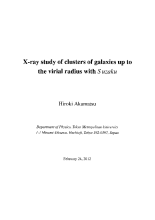X-ray study of clusters of galaxies up to the virial radius with Suzaku 「すざく」衛星による銀河団外縁部までのX線放射の研究
Access this Article
Search this Article
Author
Bibliographic Information
- Title
-
X-ray study of clusters of galaxies up to the virial radius with Suzaku
- Other Title
-
「すざく」衛星による銀河団外縁部までのX線放射の研究
- Author
-
赤松, 弘規
- Author(Another name)
-
アカマツ, ヒロキ
- University
-
首都大学東京
- Types of degree
-
博士 (理学)
- Grant ID
-
甲第255号
- Degree year
-
2012-03-25
Note and Description
博士論文
Clusters of galaxies, containing 10-1000 of galaxies, are the largest virialized structures in the Universe. They consist of galaxies, X-ray emitting hot gas (ICM: intracluster medium) with temperature reaching 107 ~ 108 K, and the dark matter. The ICM temperature inferred from a cluster X-ray spectrum therefore indicates the depth of the cluster potential well, and the emission-line strengths in the spectrum indicate the abundances of elements like iron, oxygen, and silicon in the ICM. Clusters of galaxies are regarded as useful probes to study the cosmic evolution by several reasons: 1) since the dynamical timescale of clusters is close to the Hubble time, clusters retain the cosmological initial conditions well, 2) clusters can be described by a simple model consisting of dark matter, hot gas, and galaxies, and also the shape is almost spherical, thus they are easy to deal with and 3) though a part of metals produced in galaxies flow out into ICM, they do not escape away from clusters. In understanding the dynamical evolution of clusters of galaxies, it is important to investigate the physical conditions of ICM in the cluster outskirts, whuch can be regarded as the front line of cluster evolution. For this purpose, we analyzed data from 15 Suzaku observations of clusters of galaxies, which include 9 relaxed and 6 merging system with the little including 4 radio relic clusters. They have redshifts z < O.2. Based on the spatially resolved energy spectra, we obtained precise temperature and density profiles beyond the virial radius in a systematic way. As a result, the ICM temperatures in the relaxed systems commonly show decrease from the centers to the outskirt regions and show flatter profiles in merging systems. Those difference in the temperature profile reflect stage of the dynamical evolution of clusters of galaxies. In the radio relic clusters, we found that the temperature, electron density and pressure show significant drops across the radio relics, suggesting the existence of shock fronts at radio relics. The derived Mach numbers based on Rankine-Hugoniot jump condition span the range of 2-3, and the value are consistent with the Mach numbers derived from radio observations. In the relaxed clusters, the temperature drops from the peak level (reaching w at around ~ 0.1 r2oo) to the value at r2oo by a factor of 2~5, which agrees with the results from numerical simulations of the cluster formation based on the ACDM framework. Observed entropy profiles show a flatting around outskirts except for the low temperature system. The deviation of the observed entropy profile from the numerical simulation shows ahint of the temperature dependence. Those features support the view that large systems are still evolving and their outskirts are still in a dynamically non-equilibrium state.
首都大学東京, 2012-03-25, 博士(理学)
